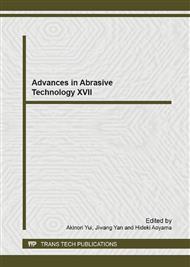p.726
p.735
p.741
p.747
p.753
p.758
p.764
p.770
p.776
Effect of Frequency and Amplitude on the Performance of Elliptic Vibration-Assisted Cutting of Fibre-Reinforced Polymer Composites
Abstract:
To effectively machine fibre-reinforced polymer composites using a simple tool, the authors have developed an elliptic vibration-assisted (EVA) cutting technique by applying micro-scale vibrations to a tool tip. This investigation aims to understand the effect of vibration frequency and amplitude on the EVA cutting performance. With the aid of a microstructure-based 3D finite element analysis, this study found that an increased vibration frequency or amplitude can accelerate the fracture of fibres, and reduce cutting forces in both the cutting and normal directions. The fracture mechanism was found to be dominated by the bending of fibres when the vibration frequency or amplitude in the cutting direction was small. With increasing the frequency or amplitude, impact-induced fracture becomes dominant, which reduces subsurface damage. It was found that to promote the performance of EVA cutting, the vibration frequency and amplitude of the cutting tool should be high. However, a too large frequency can bring about severe subsurface damage and bending fracture of fibres beneath the cutting path. A too large amplitude in the cutting direction, however, can accelerate the tool wear, while that in the vertical direction can worsen the fibre-matrix debonding.
Info:
Periodical:
Pages:
753-757
Citation:
Online since:
September 2014
Authors:
Price:
Сopyright:
© 2014 Trans Tech Publications Ltd. All Rights Reserved
Share:
Citation:


